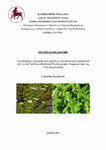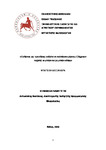| dc.creator | Levizou E., Zanni A.A., Antoniadis V. | en |
| dc.date.accessioned | 2023-01-31T08:50:04Z | |
| dc.date.available | 2023-01-31T08:50:04Z | |
| dc.date.issued | 2019 | |
| dc.identifier | 10.1007/s11356-018-2658-y | |
| dc.identifier.issn | 09441344 | |
| dc.identifier.uri | http://hdl.handle.net/11615/75793 | |
| dc.description.abstract | Varying concentrations of soil Cr(VI) were used in order to explore the tolerance thresholds and phytoremediation potential of Greek oregano (Origanum vulgare), in a pot experiment conducted outdoors. Oregano exhibited a rather exceptional capacity to bioaccumulate Cr in both the aerial part (up to 1200 mg of total Cr kg −1 DM) and the root—reaching 4300 mg kg −1 DM when grown in soil [Cr(VI)] of 150–200 mg kg −1 . Plant responses indicated that there was a threshold set at 100 mg Cr(VI) kg −1 in the soil, above which the following results were recorded: (i) a restriction of Cr translocation from below- to above-ground plant part, (ii) a raise of the soil-to-root Cr transfer, and (iii) the Cr(III) evolution from the reduction of Cr(VI) was significantly decelerated in the root and accelerated in the aerial part. Soil [Cr] that surpassed this threshold challenged plant tolerance, resulting in a dose-dependent reduction of growth and antioxidant phenolics pool. Nonetheless, the significant Cr uptake capacity at plant level accounted for the considerably short remediation time (i.e., 29 years at soil [Cr(VI)] of 150 mg kg −1 ) calculated according to these results. The overall performance of oregano indicated that phytoremediation would be feasible at sites with Cr contamination levels ranging within the above-defined thresholds. © 2018, Springer-Verlag GmbH Germany, part of Springer Nature. | en |
| dc.language.iso | en | en |
| dc.source | Environmental Science and Pollution Research | en |
| dc.source.uri | https://www.scopus.com/inward/record.uri?eid=2-s2.0-85049173111&doi=10.1007%2fs11356-018-2658-y&partnerID=40&md5=31102c46f8eaf7751eee21828c3a2bf4 | |
| dc.subject | antioxidant | en |
| dc.subject | bioaccumulation | en |
| dc.subject | chromium | en |
| dc.subject | concentration (composition) | en |
| dc.subject | growth | en |
| dc.subject | heavy metal | en |
| dc.subject | herb | en |
| dc.subject | organometallic compound | en |
| dc.subject | phenolic compound | en |
| dc.subject | phytoremediation | en |
| dc.subject | pollution effect | en |
| dc.subject | tolerance | en |
| dc.subject | translocation | en |
| dc.subject | Origanum | en |
| dc.subject | Origanum vulgare | en |
| dc.subject | chromium | en |
| dc.subject | aerial plant part | en |
| dc.subject | analysis | en |
| dc.subject | bioremediation | en |
| dc.subject | chemistry | en |
| dc.subject | dose response | en |
| dc.subject | drug effect | en |
| dc.subject | drug tolerance | en |
| dc.subject | metabolism | en |
| dc.subject | Origanum | en |
| dc.subject | plant root | en |
| dc.subject | soil | en |
| dc.subject | soil pollutant | en |
| dc.subject | Biodegradation, Environmental | en |
| dc.subject | Chromium | en |
| dc.subject | Dose-Response Relationship, Drug | en |
| dc.subject | Drug Tolerance | en |
| dc.subject | Origanum | en |
| dc.subject | Plant Components, Aerial | en |
| dc.subject | Plant Roots | en |
| dc.subject | Soil | en |
| dc.subject | Soil Pollutants | en |
| dc.subject | Springer Verlag | en |
| dc.title | Varying concentrations of soil chromium (VI) for the exploration of tolerance thresholds and phytoremediation potential of the oregano (Origanum vulgare) | en |
| dc.type | journalArticle | en |




